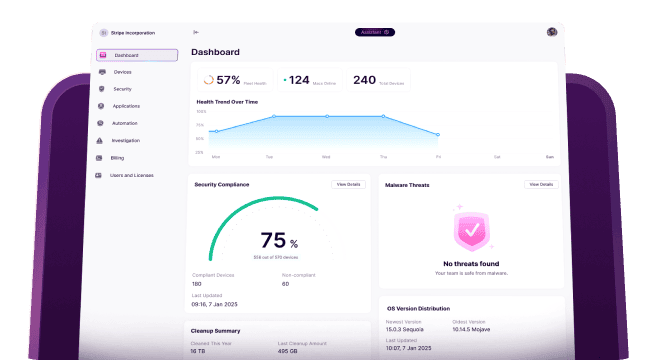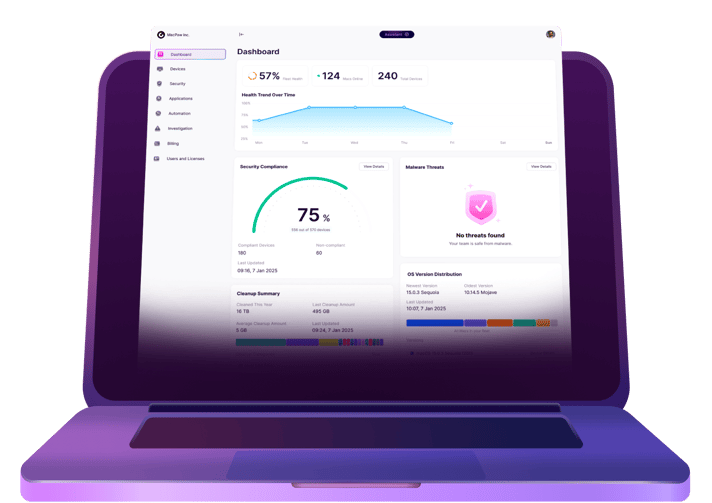Anyone who works in IT knows that it’s impossible to overemphasize the importance of security. It seems like every day, there’s some new threat that IT teams need to be worried about — or at least aware of — so that they can protect their business environment. In a world where cyber threats are rapidly evolving, it’s so crucial to stay ahead of the curve.
But you already know that, which is why you’re here in the first place. In this article, I’ll dive into the types of threats to information security you’re likely to encounter. You’ll also read about the tools and tricks you can use to help safeguard your company against these threats.
What are cybersecurity threats?
Let’s start with the basics. First, we need to answer the question: what exactly are cybersecurity threats?
It can be a bit muddled to try and distill them into just one thing. But, basically, it’s an activity or event that can compromise your company’s confidential information. That includes files and data as well as access to hardware like servers and firewalls.
Typically, if you were to imagine someone stealing files, you’d imagine some nerdy hacker somewhere in a dark basement. The truth is cybersecurity threats come from anywhere. While malicious hackers are responsible for some of these attacks, they can also be from nation-states or even disgruntled employees.
Whoever is ultimately responsible for these threats doesn’t change the fact that they can have devastating effects on your company. A cybersecurity attack can cause financial loss or impact your day-to-day business, with customers losing faith in your product because of it.
Common computer security threats

Before you’re able to effectively tackle threats, you have to know what you’re dealing with. Let’s take a look at some of the common threats every IT professional needs to know about.
- Malware: As the name implies, it’s malicious software. Malware is designed to breach your environment, causing damage and, in extreme cases, disabling your systems. Popular examples of malware are things like viruses and ransomware.
- Phishing: We’ve all received those deceptive emails that prompt you to change your password to an account or try to get you to log in to track a package you didn’t order. This is a social engineering trick used to try and steal users’ account information or download malware.
- Insider threats: This is when someone inside your organization gets access to information and mishandles it either accidentally or intentionally.
- Denial-of-Service (DoS) Attacks: DoS attacks are, unfortunately, very common. They work by overwhelming a system with requests so that it can’t keep up. Clogging the entire system and making it totally unusable.
- Man-in-the-middle (MITM) attacks: Just like it sounds — when a person steals communication between two people. This is a particularly common tactic of hackers who target public Wi-Fi networks.
How IT teams can protect against threats to information security
I know you just read in detail about all of the ways your organization is at risk, but I promise it’s not all doom and gloom. There are some techniques you and your team can use to protect your environment against these threats. Let’s learn more about the most effective ways to deal with cyber security threats.
Implement comprehensive security policies
It’s important to create easy-to-follow security policies in place. Part of that is making sure you clearly and concisely communicate them to all of the employees. If they can’t understand it, then they’re not going to follow any policy — regardless of how critical it is. These basic security policies should include things like password management and regular training to educate employees.
Keep systems updated
Every user hates doing software updates on their machines, but that’s only half the battle. You need to have a schedule for not only how often you push end-user updates but also for servers and other equipment. New updates can help you protect your equipment and reduce the risk of exploitation.
Monitor network activity
Keeping an eye on your network activity is a critical step to protecting your infrastructure. You can use an intrusion detection system (IDS) and intrusion prevention system (IPS) to help you spot any unusual activity on your network.
Encrypt data
Encryption is a vital component of any cybersecurity strategy. But it’s crucial to encrypt the data on your individual machines and when it’s in transit, whether that’s copying files to an external hard drive or uploading to a server. Using encryption can help reduce the risk of data breaches from unauthorized access.
Back up regularly
Obviously, backing up data is a critical part of making sure you don’t lose important data. One of the most common threats is ransomware. If you’re not familiar with what that is, that’s when a virus locks a computer or server until a ransom is paid to the hackers. Having a reliable backup means you won’t have to barter with cyber criminals to get your data back.
Conduct risk assessments
As technology changes, you need to regularly evaluate your company’s security strategy. Doing risk assessments can help you figure out possible vulnerabilities and prioritize what needs to be fixed.
Collaborate and share intelligence
Knowing about new security trends and staying ahead of the curve is one of the best defenses you can have against attacks. Monitoring emerging threats can help you protect your environment and employees before it’s too late.
As an IT professional, you’re the frontline of defense for your company’s data. Staying informed about the latest threats and learning how to prevent them is the best way you can minimize the risk for your business.
Hopefully, after reading this article, you feel even more empowered to implement new policies to safeguard your environment and ready to take the leap into leading some more training for all of the employees you need to support.









